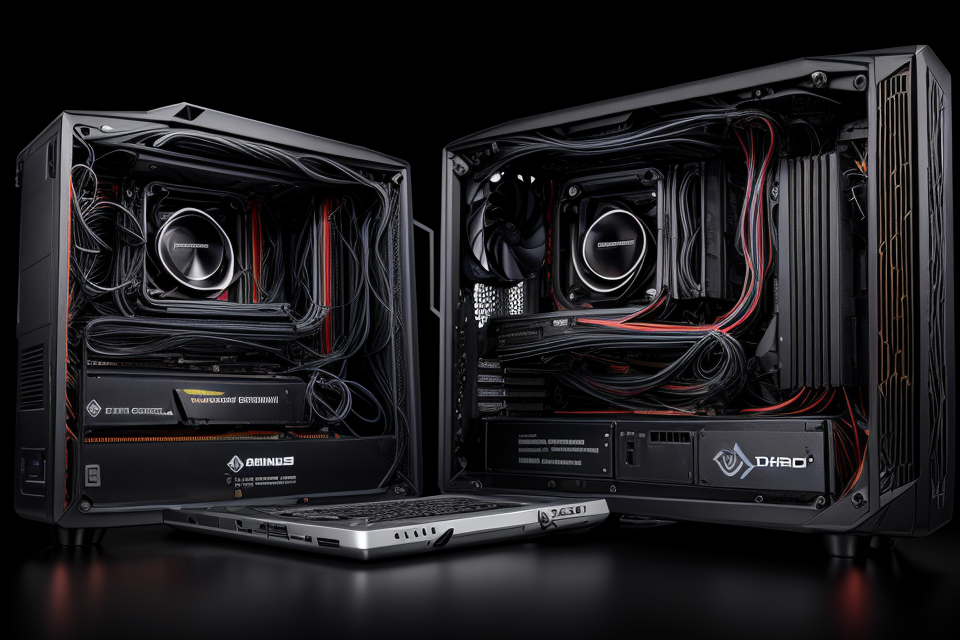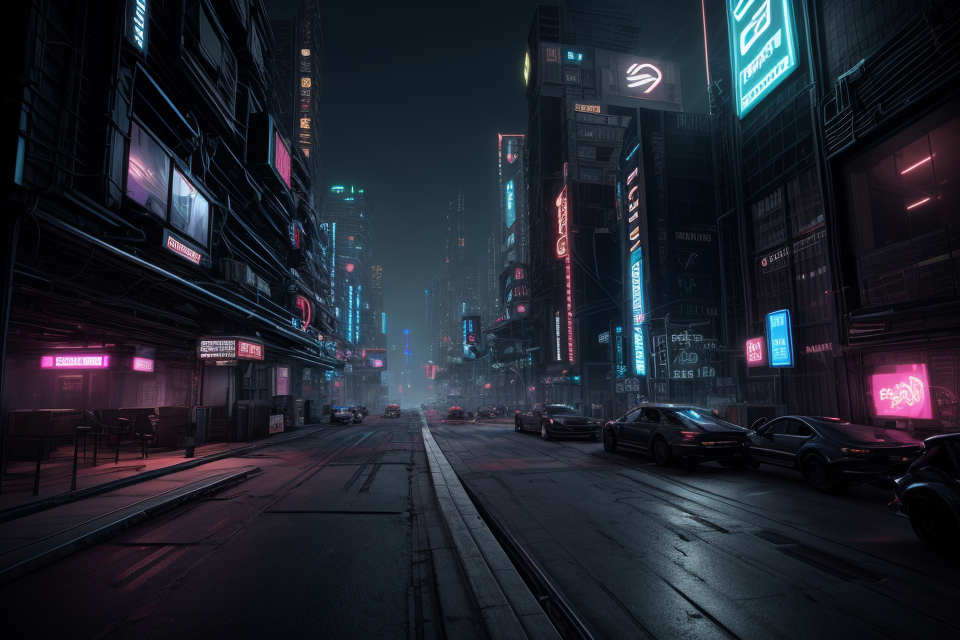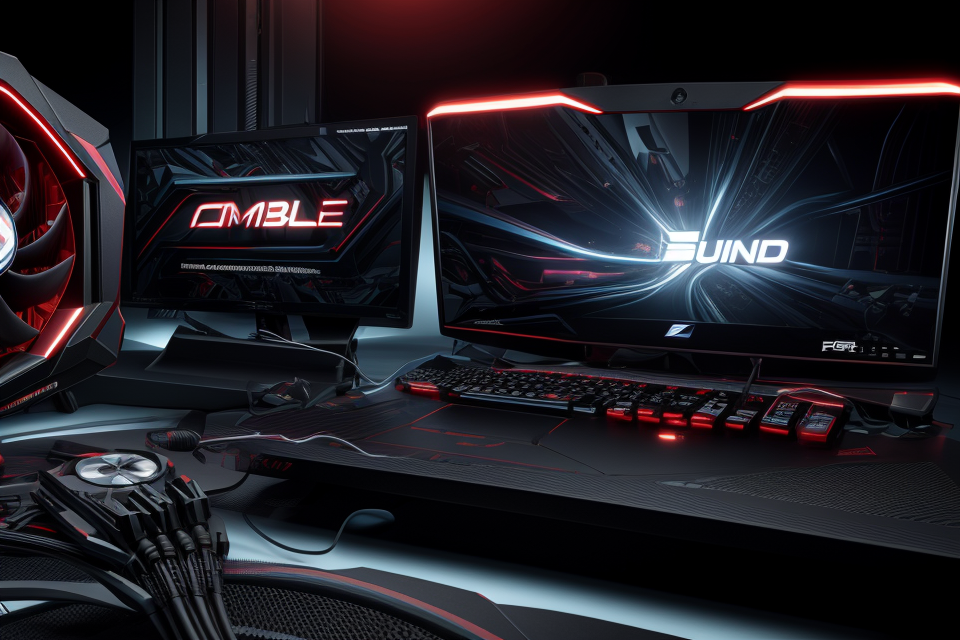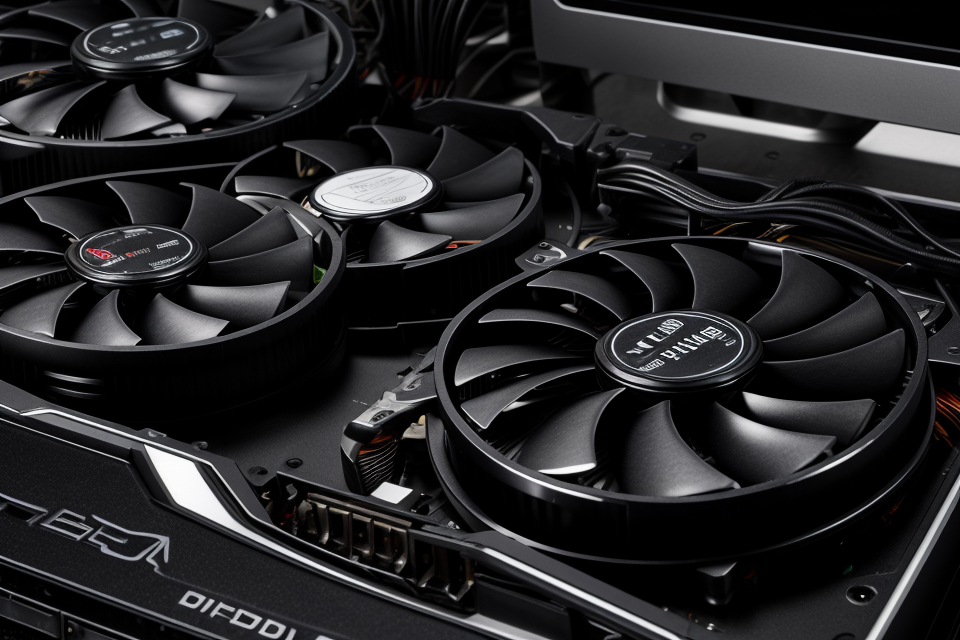
Are you tired of your GPU crashing at the most inopportune moments? Fear not, dear gamer! In this comprehensive guide, we will delve into the world of GPU crashes and equip you with the knowledge and tools to troubleshoot and fix them. From identifying the root cause to implementing effective solutions, we’ve got you covered. Whether it’s overheating, driver issues, or software conflicts, we’ll explore the various factors that can cause your GPU to crash and provide you with practical tips to get your gaming back on track. So, gear up, and let’s dive into the world of GPU troubleshooting!
Understanding GPU Crashes
Causes of GPU Crashes
GPU crashes can be caused by a variety of factors, some of which include:
- Overheating: When the GPU’s temperature exceeds the safe limit, it can cause the GPU to crash. This can happen due to poor airflow or dust accumulation in the computer’s case, or due to a faulty thermal paste or cooling system.
- Faulty hardware: A malfunctioning GPU can also cause crashes. This can be due to a manufacturing defect or damage to the GPU.
- Driver issues: Incorrect or outdated graphics drivers can cause crashes. This can happen if the drivers are not compatible with the GPU or the operating system.
- Incompatible software: Some software applications may not be compatible with the GPU, leading to crashes. This can happen if the software requires a specific GPU feature that the current driver does not support.
- Power supply problems: Power supply issues can also cause GPU crashes. This can happen if the power supply is not providing enough power to the GPU or if there are voltage fluctuations in the power supply.
Symptoms of GPU Crashes
- Screen freezing: One of the most common symptoms of a GPU crash is a frozen screen. This can happen when the GPU encounters an error and is unable to process the graphics being displayed on the screen. The screen may become unresponsive, and the user may have to hard reset the system to regain control.
- Blue screen: A blue screen, also known as the “Blue Screen of Death” (BSOD), is another symptom of a GPU crash. This error screen is displayed by the operating system when it encounters a critical error that it cannot recover from. A blue screen may indicate a problem with the GPU, the drivers, or other hardware components.
- System crashes: A system crash can occur when the GPU fails to function properly. This can result in the entire system becoming unresponsive, and the user may have to restart the computer to regain access to their files and programs.
- Graphical artifacts: Graphical artifacts, such as ghosting, tearing, or stuttering, can also be symptoms of a GPU crash. These artifacts can occur when the GPU is unable to render graphics correctly, resulting in distorted or corrupted images on the screen.
- Gaming performance issues: A GPU crash can also cause performance issues in games. The graphics may appear jittery or stutter, and the frame rate may drop significantly. This can result in a poor gaming experience and may require the user to restart the game or the entire system to resolve the issue.
Diagnosing GPU Crashes
Checking System Logs
When troubleshooting GPU crashes, checking system logs can provide valuable information that can help identify the root cause of the issue. Here are some tools that can be used to check system logs:
Windows Event Viewer
Windows Event Viewer is a built-in tool that allows users to view and analyze system events. To check for GPU-related events, follow these steps:
- Open Windows Event Viewer by typing “Event Viewer” in the Windows search bar and selecting the “Event Viewer” app.
- In the left-hand panel, click on “Windows Logs” and then select “System.”
- In the middle pane, look for events related to the GPU, such as “GPU failures” or “GPU-related errors.”
- These events can provide useful information about the specific issue, such as the time and date of the crash, the GPU model, and any error codes or messages.
GPU-Z
GPU-Z is a free utility that provides detailed information about the graphics card installed in your computer. It can be used to check the GPU temperature, memory usage, and other important parameters. To use GPU-Z, follow these steps:
- Download and install GPU-Z from the official website.
- Open GPU-Z and select the GPU you want to monitor from the list of available devices.
- Check the temperature, memory usage, and other parameters to ensure that they are within normal ranges.
- If there are any abnormal values or issues, it may indicate a problem with the GPU that could be causing crashes.
MSI Afterburner
MSI Afterburner is a free utility that allows users to overclock their graphics cards and monitor their performance. It can also be used to check system logs related to GPU crashes. To use MSI Afterburner, follow these steps:
- Download and install MSI Afterburner from the official website.
- Open MSI Afterburner and select the GPU you want to monitor from the list of available devices.
- Enable the “Log” feature to save log files that can be used to diagnose GPU crashes.
- If a crash occurs, the log file can be analyzed to identify the specific issue and help determine the appropriate course of action.
Overall, checking system logs can provide valuable information that can help diagnose and fix GPU crashes. By using tools like Windows Event Viewer, GPU-Z, and MSI Afterburner, users can gain a better understanding of their GPU’s performance and identify potential issues that may be causing crashes.
Running Stress Tests
When experiencing GPU crashes, running stress tests can help identify potential issues. Stress tests push the GPU beyond its normal workload, simulating demanding graphics scenarios to determine its stability and potential weak points. Three popular stress tests for GPUs are FurMark, GPU-T, and 3DMark.
- FurMark: FurMark is a free, open-source GPU stress testing tool designed specifically for AMD graphics cards. It can push your GPU to its limits and test its stability under extreme conditions. To use FurMark, download the application, run it, and select the desired GPU core clock and memory clock speed. FurMark will then stress test your GPU for a specified duration.
- GPU-T: GPU-T (GPU-Trial) is another free, open-source GPU stress testing tool that supports both AMD and NVIDIA graphics cards. It allows users to stress test their GPUs with different workloads, including 3D and 2D tests. GPU-T is known for its comprehensive reporting, which provides detailed information about GPU performance, stability, and temperature during stress testing.
- 3DMark: 3DMark is a popular benchmarking tool designed to test the performance of your GPU in various graphics scenarios. It offers a range of tests, including Time Spy, Fire Strike, and Port Royal, which simulate real-world gaming and graphics workloads. By running 3DMark, you can evaluate your GPU’s stability and performance under stress, helping you identify potential issues that may be causing crashes.
It is important to note that running stress tests should be done with caution, as overextending your GPU may cause permanent damage. Always monitor your GPU’s temperature and other vital components during stress testing and ensure that your system is adequately cooled. Additionally, if you notice any abnormal behavior or instability during stress testing, it may indicate a faulty GPU, and it is recommended to seek professional assistance for further diagnosis and repair.
Troubleshooting Utilities
- GPU-Shim:
- Description: GPU-Shim is a lightweight utility that is designed to provide stability and performance improvements for NVIDIA graphics cards. It is particularly useful for users who experience frequent crashes or freezes.
- Functionality: GPU-Shim works by providing a compatibility layer between the operating system and the graphics card driver. This helps to prevent crashes caused by conflicts between different software components.
- Installation: To install GPU-Shim, download the utility from the official website and follow the instructions provided. It is recommended to run GPU-Shim during system startup to ensure that it is always active.
- Additional Notes: GPU-Shim is compatible with a wide range of NVIDIA graphics cards and is a good starting point for troubleshooting GPU crashes.
- RivaTuner:
- Description: RivaTuner is a popular overclocking utility that can also be used for troubleshooting GPU crashes. It provides a range of features, including stress testing, GPU-Z, and memory testing.
- Functionality: RivaTuner can help identify issues with the graphics card and the driver by running stress tests and monitoring system performance. It can also provide detailed information about the GPU, including temperature, clock speed, and memory usage.
- Installation: To install RivaTuner, download the utility from the official website and follow the instructions provided. It is recommended to run RivaTuner during system startup to ensure that it is always available.
- Additional Notes: RivaTuner is compatible with a wide range of graphics cards and is a useful tool for diagnosing GPU crashes.
- AIDA64:
- Description: AIDA64 is a diagnostic utility that provides detailed information about the system’s hardware and software components. It can be used to diagnose a range of issues, including GPU crashes.
- Functionality: AIDA64 provides detailed information about the GPU, including temperature, clock speed, and memory usage. It can also detect hardware conflicts and provide recommendations for resolving them.
- Installation: To install AIDA64, download the utility from the official website and follow the instructions provided. It is recommended to run AIDA64 during system startup to ensure that it is always available.
- Additional Notes: AIDA64 is compatible with a wide range of hardware and is a useful tool for diagnosing GPU crashes.
Fixing GPU Crashes
Overclocking
Overclocking is the process of increasing the clock speed and voltage of a GPU beyond its default settings, which can potentially improve its performance. However, it is important to note that overclocking can also cause instability and may result in crashes. Therefore, it is essential to carefully monitor the GPU’s temperature and voltage while overclocking to avoid damage to the hardware.
Risks and benefits
Overclocking a GPU can have several benefits, such as increased performance and improved gaming experience. However, it also comes with risks, such as instability, overheating, and hardware damage. Overclocking can cause the GPU to draw more power, which can lead to overheating and thermal throttling, resulting in crashes.
Monitoring temperatures
When overclocking a GPU, it is crucial to monitor its temperature to ensure that it does not exceed the safe limit. The GPU’s temperature can be monitored using software tools such as MSI Afterburner, EVGA Precision X10, or AIDA64 Extreme. These tools provide real-time temperature readings and can alert the user if the temperature exceeds the safe limit.
Adjusting voltage and clock speeds
To overclock a GPU, the user needs to adjust its voltage and clock speeds using software tools such as MSI Afterburner or EVGA Precision X10. These tools allow the user to increase the GPU’s clock speed and voltage beyond their default settings. However, it is important to note that increasing the voltage too much can cause instability and damage to the hardware. Therefore, it is recommended to increase the voltage gradually and monitor the GPU’s temperature to ensure that it does not exceed the safe limit.
It is also important to note that overclocking can void the GPU’s warranty, and it may cause instability or damage to the hardware if not done properly. Therefore, it is recommended to proceed with caution and monitor the GPU’s temperature and voltage while overclocking.
Driver Updates
Manually updating drivers
One of the first steps in troubleshooting and fixing GPU crashes is to ensure that your graphics driver is up to date. You can manually update your graphics driver by following these steps:
- Open the Device Manager: You can do this by pressing the Windows key + X, and then selecting Device Manager from the menu.
- Locate your graphics card: In the Device Manager, locate your graphics card under the “Display adapters” section.
- Update the driver: Right-click on your graphics card and select “Update driver”. Windows will then search for the latest driver and install it on your system.
If the manual update process does not work, you can try using a GPU-specific driver updater.
Using GPU-specific driver updaters
GPU-specific driver updaters are designed to scan your system for outdated graphics drivers and update them automatically. Here are some popular GPU-specific driver updaters:
- AMD Radeon Software: This is a free driver updater from AMD that provides automatic updates for all AMD graphics products.
- NVIDIA GeForce Experience: This is a free driver updater from NVIDIA that provides automatic updates for all NVIDIA graphics products. It also includes additional features such as automatic driver optimization for games.
- Display Driver Uninstaller (DDU): This is a free tool that can be used to safely and completely remove old graphics drivers before installing new ones.
By using a GPU-specific driver updater, you can ensure that your graphics driver is always up to date, which can help prevent GPU crashes.
Power Supply Check
Ensuring Proper Power Supply
One of the most common causes of GPU crashes is insufficient or unstable power supply. It is crucial to ensure that your power supply unit (PSU) is capable of delivering the required wattage to your GPU. To determine the appropriate wattage, you should consult the manufacturer’s specifications for your GPU and PSU. It is recommended to use a PSU with a higher wattage than the minimum required to account for any potential future upgrades or increased usage.
Checking Connections
After ensuring proper power supply, the next step is to check the connections between the PSU and the GPU. Make sure that all cables are securely connected and not loose or frayed. Any loose connections can cause instability in the power supply, leading to GPU crashes. Double-check that the 24-pin ATX cable, PCIe cables, and SATA cables are all securely connected to the correct ports on the motherboard and GPU.
Replacing Faulty Power Supplies
If you have ruled out insufficient or unstable power supply as the cause of your GPU crashes, the next step is to check the PSU itself. A faulty PSU can cause instability in the power supply, leading to crashes. If you suspect that your PSU is faulty, it is recommended to replace it with a new one. When selecting a new PSU, make sure to choose one with the appropriate wattage and certifications, such as 80 PLUS Bronze, Silver, Gold, Platinum, or Titanium. These certifications ensure that the PSU is energy-efficient and reliable.
Software Compatibility
GPU crashes can sometimes be caused by incompatible software. Here are some steps to check and fix software compatibility issues:
Checking for incompatible software
The first step in fixing software compatibility issues is to identify the software that may be causing the problem. Here are some ways to check for incompatible software:
- Check the system requirements for the software you are using. Make sure that your GPU meets the minimum requirements for the software.
- Check for any updates or patches for the software. Sometimes, updating the software can fix compatibility issues.
- Check for any conflicting software that may be running at the same time. For example, some antivirus software may conflict with certain GPU-intensive programs.
Disabling unnecessary programs
If you have identified that some software is causing the GPU crash, you can try disabling it to see if it fixes the issue. To do this, follow these steps:
- Open the Task Manager by pressing Ctrl + Alt + Delete.
- Click on the “Details” tab.
- Look for any software that may be causing the problem and disable it.
- Restart your computer and see if the GPU crash has been fixed.
Rolling back drivers
If disabling the software does not fix the issue, you can try rolling back the drivers for your GPU. Here are the steps to do this:
- Open the Device Manager by pressing Windows key + X and selecting Device Manager.
- Expand the “Display adapters” section and right-click on your GPU.
- Select “Properties” and then select “Roll Back Driver”.
- Follow the prompts to roll back the driver to a previous version.
- Restart your computer and see if the GPU crash has been fixed.
By following these steps, you can fix software compatibility issues that may be causing GPU crashes.
Preventing Future GPU Crashes
Cooling Solutions
Air Cooling
Air cooling is the most basic and common method of cooling a GPU. It involves using a heatsink and fan to dissipate heat from the GPU. This method is cost-effective and easy to implement. However, it may not be sufficient for high-performance GPUs or when the system is subjected to prolonged use.
Liquid Cooling
Liquid cooling is a more advanced method of cooling a GPU. It involves using a liquid coolant to transfer heat away from the GPU. This method is more effective than air cooling and can provide better cooling performance. However, it requires more complex setup and maintenance.
Fan Replacements
Replacing the stock fans with higher-quality fans can also improve the cooling performance of a GPU. High-quality fans are designed to spin at a lower RPM while still providing adequate airflow. This can help reduce noise and improve the lifespan of the GPU.
In addition to these methods, proper thermal paste application and cleaning can also help improve the cooling performance of a GPU. Regular maintenance and cleaning of the cooling system is also essential to ensure optimal performance.
Maintenance
- Dust removal
- Regular driver updates
- Monitoring temperatures
Dust Removal
GPU crashes can often be caused by the accumulation of dust and debris inside the system. Regular maintenance of the system is essential to prevent these issues.
The first step in removing dust from the system is to shut down the computer and unplug it from the power source. Next, open the case of the computer and carefully remove the graphics card.
Use a can of compressed air to blow out any dust or debris that may have accumulated on the card. Be sure to aim the can directly at the card and not at any other components, as the force of the air can cause damage.
Once the card is clean, reinsert it into the case and replace the side panel. Restart the computer and check for any errors or crashes.
Regular Driver Updates
Another important aspect of maintaining the system is keeping the drivers up to date. Graphics card drivers are critical to the proper functioning of the card and should be updated regularly.
Manufacturers often release updates to address bugs and improve performance. These updates should be installed as soon as they become available to ensure that the system is running smoothly.
Monitoring Temperatures
Graphics cards can become very hot during use, and high temperatures can cause crashes and other issues. It is important to monitor the temperatures of the system to prevent these problems.
Most graphics cards have built-in sensors that can monitor the temperature of the card. These sensors can be accessed through the computer’s system monitoring tools.
If the temperature of the card is too high, it may be necessary to adjust the power settings or the cooling system to bring the temperature down. It is also important to ensure that the computer is in a well-ventilated area to prevent overheating.
By following these maintenance procedures, it is possible to prevent future GPU crashes and ensure that the system is running smoothly.
Safe Gaming Practices
- Maintaining Proper Ventilation
- Ensuring adequate airflow around the GPU to prevent overheating
- Dust buildup can hinder airflow, regular cleaning of the computer’s case and fans is recommended
- Overclocking Safely
- Increasing the clock speed of the GPU can improve performance, but can also increase the risk of crashes
- Overclocking should be done with caution and careful monitoring of temperatures and stability
- Overclocking tools can help in achieving the desired clock speeds safely
- Avoiding Unnecessary Stress Tests
- Running stress tests for extended periods can cause the GPU to overheat and crash
- Stress tests should be used sparingly and only when necessary for diagnosing specific issues
- Stress testing should be done for short durations and with proper cooling solutions in place.
FAQs
1. What causes a GPU crash?
GPU crashes can be caused by a variety of factors, including overheating, outdated drivers, hardware failure, and conflicts with other software.
2. How can I tell if my GPU is overheating?
If your GPU is overheating, you may notice that the fan is running louder than usual or that the GPU temperature displayed in your system’s monitoring tools is higher than normal. In some cases, the GPU may also throttle its performance to prevent overheating, which can cause stuttering or other issues.
3. How can I update my GPU drivers?
To update your GPU drivers, you will need to visit the website of your GPU manufacturer and download the latest drivers for your specific model. You may also want to check for any additional software or firmware updates that may be available.
4. Can I fix a hardware failure on my own?
In most cases, hardware failures on a GPU require professional repair or replacement. If you suspect that your GPU has a hardware failure, it is best to contact the manufacturer or a qualified technician for assistance.
5. How can I troubleshoot conflicts with other software?
To troubleshoot conflicts with other software, you will need to disable or remove any unnecessary programs and check for any conflicting software or drivers. You may also want to try updating your operating system or reinstalling the software that is causing the conflict.
6. What should I do if my GPU crashes frequently?
If your GPU crashes frequently, it may be a sign of a more serious issue. You should try updating your drivers and software, checking for overheating, and ensuring that your system is properly ventilated. If the problem persists, it may be best to contact the manufacturer or a qualified technician for assistance.


